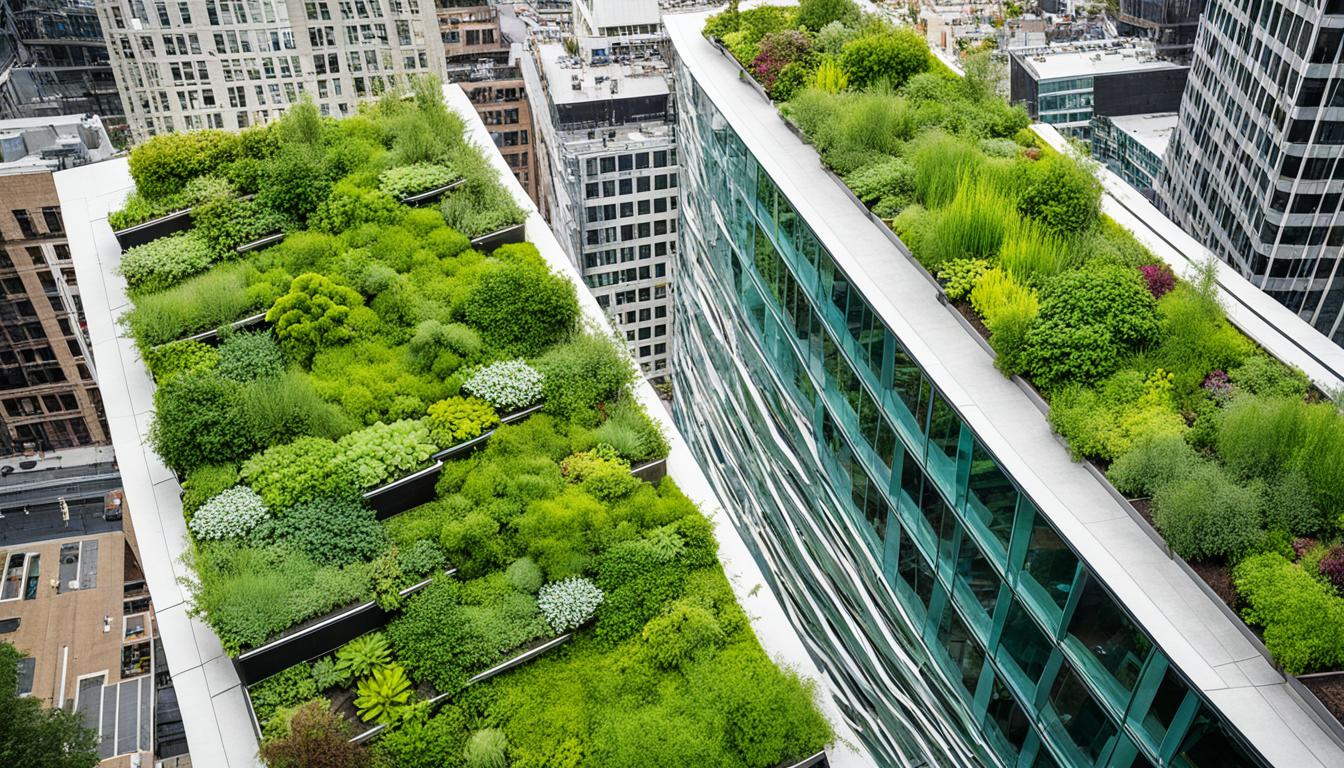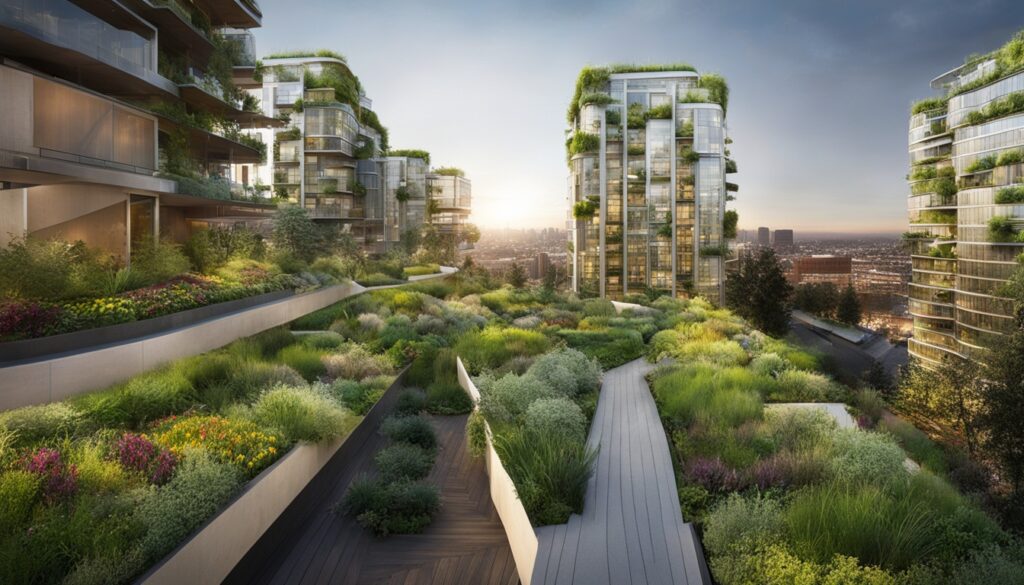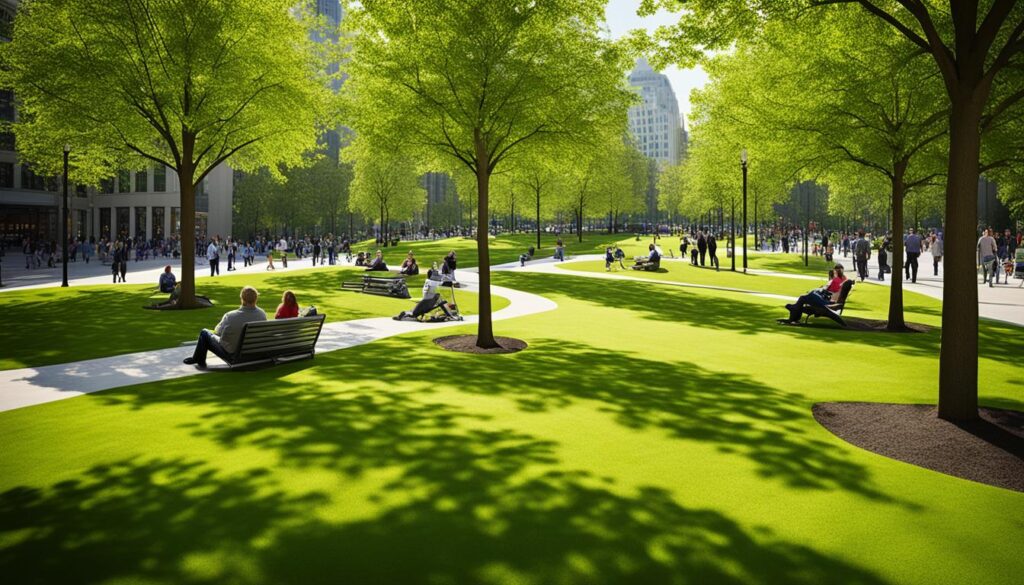
Cities worldwide are taking on the task of rewilding. This means returning areas to a wild, natural state. It’s about adding architecture and design that support nature. This helps by bringing back local plants, creating parks in unused spaces, designing buildings that connect with nature, and letting nature reclaim some areas. The benefits for people in cities, who often lack outdoor options, are clear. Rewilding does wonders for their health.
This piece looks at urban rewilding projects in cities such as Singapore, Nottingham, Haerbin, and Dublin. It shows how rewilding boosts biodiversity, helps fight climate change, and makes communities happier. These projects highlight the power of nature-positive architecture. They change the way we build and live in our cities for the better.
Key Takeaways
- Rewilding urban spaces involves restoring areas to their original, uncultivated state and incorporating new elements of architectural or landscape design.
- Biophilic design and sustainable urbanism are key components of nature-positive architecture, which aims to create built environments that foster biodiversity and enhance community well-being.
- Successful urban rewilding projects, such as the Gardens by the Bay in Singapore and the Qunli National Urban Wetland in Haerbin, China, demonstrate the environmental and social benefits of integrating nature into cities.
- Innovative approaches to urban rewilding, including rooftop gardens, green walls, and the use of sustainable materials, are transforming underutilised urban spaces into biodiverse pockets.
- Promoting community engagement and education is crucial to addressing challenges and misconceptions surrounding urban rewilding initiatives.
Understanding Rewilding
Rewilding is a new way to let nature be wild again. It aims to turn an area back into its natural state. This approach is different from how we’ve managed nature for a long time. It lets wild areas become wild once more. Also, it might add new things, like special landscape designs or buildings.
Principles and Goals of Rewilding
Rewilding isn’t just for wilderness areas. Cities are also getting into urban rewilding. They’re bringing back plants and animals that belong there. Parks and places designed to look and feel natural are part of this. The idea is to make cities greener places where people can relax and enjoy nature.
The Importance of Biodiversity Conservation
Rewilding is key for saving different plants and animals. It helps make nature stronger. It also gives a boost to species that are struggling. By joining small habitats and making new green areas in cities, rewilding helps keep nature in balance.
| Rewilding Principles | Rewilding Goals |
|---|---|
| Restoring uncultivated landscapes | Reintroducing native species |
| Allowing natural processes to take over | Enhancing biodiversity |
| Integrating new design elements | Improving human well-being |
| Shifting away from human control | Restoring ecological balance |

The Concept of Nature-Positive Architecture
Nature-positive architecture aims to make our buildings friendly to nature. It helps biodiversity, fights climate change, and makes life better for everyone. This approach is key in making our cities more sustainable. Cities are focusing on bringing back the environment and adding more green spaces.
Biophilic Design and Sustainable Urbanism
Biophilic design brings nature into our buildings. Sustainable urbanism helps city growth happen in an eco-friendly way. Together, they help architects and planners create places that work well for people and nature. This mix is important for dealing with city problems like losing nature and climate change.
Green Infrastructure and Ecological Restoration
Green infrastructure includes things like rooftop gardens and urban wetlands. It’s great for helping cities be more natural. These solutions give homes to creatures, connect nature bits, and help the earth in many ways. Putting more green spaces in cities can make them better places to live for everyone.

Environmental Benefits of Rewilding Urban Spaces
Rewilding urban spaces offers big environmental benefits. It boosts climate resilience and carbon sequestration. This is done by letting nature thrive again in cities. For example, trees capture rain and help store it, cutting impacts of climate change. Green spaces also welcome more plant and animal life, increasing diversity.
Climate Resilience and Carbon Sequestration
Adding green spaces and natural features in cities are key for climate resilience. They absorb rain and store it, lessening climate change effects. Moreover, they hold onto carbon, reducing greenhouse gas in the air.
Mitigating Urban Heat Island Effect
Urban areas can heat up a lot more than rural places, known as the urban heat island effect. Bringing in green spaces and natural parts cuts this problem. It shades the area and cools by evaporation. This makes life better for people and cuts down on air conditioning use.
| Environmental Benefit | Impact |
|---|---|
| Climate Resilience | Restoring natural areas and processes, such as rainwater capture, helps mitigate the effects of climate change. |
| Carbon Sequestration | Plants and trees in urban rewilding projects absorb and store atmospheric carbon dioxide, reducing greenhouse gas emissions. |
| Urban Heat Island Effect | Introducing green spaces and natural elements can provide shade and cooling, reducing the urban heat island effect and lowering energy consumption. |

Rewilding Urban Spaces: The Role of Nature-Positive Architecture
Nature-positive architecture is key in making urban spaces wild again. It helps by making homes for wildlife and adding green areas to cities. These designs also let creatures move between places, which is good for their genes and health.
Creating Urban Habitats and Wildlife Corridors
Rooftop gardens and living walls turn dull city spots into homes for plants and animals. These designs create pathways for wildlife to move around the city. This increases the variety of urban life and makes cities stronger against changes.
Integrating Green Spaces and Natural Elements
Nature-friendly buildings blend green spots and nature into city designs. They add everywhere from big parks to small gardens and wetlands. This makes cities more balanced, lets nature thrive, and gives people more chances to enjoy the outdoors.

Innovative Approaches to Urban Rewilding
Cities worldwide are adding more nature to their landscapes. They use new methods for rewilding urban areas. These techniques help to increase plant and animal life, make cities greener, and improve people’s health. Elements like rooftop gardens, green walls, and using nature-inspired designs are changing our view of cities and nature.
Rooftop Gardens and Green Walls
Rooftop gardens and green walls are being used more in cities. They support city wildlife and lower high temperatures in urban areas. These green features offer shade, cool the air, and play a role in air purification. They make buildings more sustainable too.
In Chippendale, Australia, One Central Park shines as an example. It has over 35,200 plants and 383 species, covering 1,120 square meters. This green space stands out in the city, showing how nature can be part of urban life.
Sustainable Materials and Biomimicry
Urban rewilding also includes using eco-friendly materials and designs inspired by nature. These help create spaces that work with the environment, not against it. Such projects focus on using renewable and nature-friendly materials. They take cues from nature’s own building and design strategies.
For instance, a Terra-cotta building facade serves as a home for bees, birds, and plants. This project, by COOKFOX Architects and Buro Happold, shows how buildings and nature can come together. It creates a home for urban wildlife while reducing the impact on the environment.
The Benefits of Urban Rewilding
Urban rewilding brings many good things, not just for the planet. Making cities greener and wilder helps clean the air. It does this by soaking up pollution and dropping the amount of dirty bits in the air. This makes it easier to breathe, lowering the chances of getting sick from the city’s air.
Improved Air Quality and Reduced Pollution
While more people move into cities, we must battle air pollution. Cities are starting to use nature and green designs to clean the air. They’re making the air fresher by using plants to catch and destroy bad stuff in the air. This helps keep people healthier and fights climate change too.
Enhanced Community Well-being and Mental Health
Urban rewilding does a lot for people’s happiness and mental health. It’s well known that being in nature is fantastic for our minds. It gives people in the city a sweet break from the hustle. By adding more green areas and fun spaces outside, cities can make their citizens happier. They lower stress, depression, and just make folks feel better in general.

Case Studies: Successful Urban Rewilding Projects
Cities worldwide are taking on the challenge of rewilding. They are showing through action the positive impact of merging nature with the urban area. Notable among these projects are the Gardens by the Bay in Singapore and the Qunli National Urban Wetland in Haerbin, China.
Gardens by the Bay, Singapore
The Gardens by the Bay in Singapore are a landmark example of urban rewilding. It has changed the city’s image from a ‘Garden City’ to a ‘City in a Garden’. Here, 18 “Supertrees” closely mimic real trees. They’re designed to not only captivate but also support over 158,000 plants, forming a rich urban ecosystem.
Additionally, Singapore’s Bishan-Ang Mo Kio Park has lessened the city’s heat and embraced water-sensitive designs. These actions strengthen Singapore’s eco-friendliness.
Qunli National Urban Wetland, Haerbin, China
In Haerbin, China, the creation of the Qunli National Urban Wetland stands out. It safeguards a central wetland, offering critical system functions. These include managing stormwater, restoring habitats, and offering places for people to relax.
Thus, apart from preserving significant natural spaces, this project has turned the area into a thriving, nature-focused hub. It benefits both the wildlife and the local society.

Overcoming Challenges and Misconceptions
Urban rewilding brings many advantages. Yet, there are hurdles and false beliefs that need attention. Urban planning and design barriers like lack of space and meeting both human and animal needs can slow rewilding projects. Also, scepticism towards rewilding exists, often linked with reintroducing large animals. Despite this, rewilding in cities mostly involves small changes.
Addressing Urban Planning and Design Constraints
Space is often a big issue in cities for rewilding work. Planners and designers must find ways for humans and wildlife to coexist. They aim to keep cities running smoothly while supporting biodiversity. Integrating green infrastructure like rooftop gardens or living walls is one approach.
Promoting Community Engagement and Education
Changing people’s wrong ideas about urban rewilding is key for its success. Community participation and teaching the public about rewilding are very important. Getting locals involved and sharing information helps overcome fears. This way, rewilding efforts gain real support from the very people they benefit.

The Future of Nature-Positive Architecture
The world is asking for cities that are sustainable and bring nature into everyday life. This has opened a big door of opportunity for the future. New tech, like smart sensors, and using data in clever ways, helps keep nature in check in cities. It also helps make cities smarter and greener by using plants and natural ways of doing things. At the same time, cities are looking at ways to bring back more of the wild in the heart of urban areas.
Integrating Technology and Smart Cities
Technology and smart cities are key to making future buildings work with nature. They use sensors to check on how nature is doing in busy places. This info helps plan cities that are better for plants, animals, and the people living there. Adding natural features like gardens on top of buildings is easier when the plants are looked after by smart systems. These efforts help places stay green and healthy for a long time.
Collaborative Efforts and Policy Initiatives
Getting nature back into cities needs everyone to team up. This includes people who make rules, plan cities, design buildings, and those who live there. Together, they can push for city designs that help nature grow. They can also create laws that support making cities wilder. This teamwork can make city life better for everyone, from plants and animals to people, making our cities strong, happy, and full of life.
The path for architecture that supports nature is bright. New technology and working together can change our cities. They can become places that are good for both nature and people, offering a better life for everyone in them.
Indigenous Perspectives and Traditional Ecological Knowledge
A more contextual approach to rewilding connects indigenous communities with their past lands. It links them with traditional ecological knowledge. This method uses the wisdom and practices of these communities.
Cultural rewilding celebrates a whole approach to conservation. It blends modern knowledge with local wisdom and history. This way, nature and people learn to live together in harmony.
The living root bridges by the Khasi people in North-East India are a great example. They show how much indigenous communities can teach us. Their ancient knowledge adds to making our cities more green and pleasant.
| Percentage of Articles Emphasizing the Importance of Traditional Ecological Knowledge in Restoration Ecology | 100% |
|---|---|
| Percentage of Articles Discussing the Contributions of Indigenous Peoples and Local Communities to Ecological Restoration | 100% |
| Percentage of Articles Advocating for the Integration of Indigenous Knowledge with Science Education for Sustainability | 100% |
| Percentage of Articles Demonstrating the Utilization of Traditional Knowledge in Ecological Restoration Practices | 100% |
| Percentage of Articles Highlighting the Role of Traditional Belief Systems in Conserving Biological Diversity | 100% |
| Percentage of Articles Focusing on the Use of Ethnomedicinal Plants by Indigenous Communities | 100% |
| Percentage of Articles Discussing the Traditional Knowledge of Diverse Ethnic Groups Related to Botanical Resources and Ecological Practices | 100% |
| Percentage of Articles Proposing the Assessment of Forest Health Indicators and Ecological Health Utilizing Traditional Knowledge | 100% |
| Percentage of Articles Discussing the Selection of Native Tree Species for Forest Restoration Based on Traditional Ecological Knowledge | 100% |
By understanding and including indigenous perspectives and traditional ecological knowledge, cities can change. They can become more green and kind to nature. This builds a strong bridge between us, nature, and our urban spaces.
Conclusion
In conclusion, making urban areas wilder with nature-friendly buildings can do a lot. It can help plants and animals thrive, make cities better at handling climate changes, and improve how we feel. By adding things like gardens on roofs and walls covered in plants, we can make big differences.
This approach mixes new ideas with old wisdom. It brings people together to make rules that help nature. Together, we can make cities that are good for everyone and still green.
Using nature to design our cities can give us really good results. It helps the environment and the people living in cities. More and more of us are moving into cities, so having nature around is very important. We’ve learnt a lot from looking into this topic.
It shows how important having wild spaces in cities is. We face big problems like losing animals and plants, changing climate, and health issues. By letting nature back into our cities, we can deal with these issues and make where we live better.
The summary of key points in this discussion includes the perks of rewilding towns. It makes the air cleaner, reduces harmful stuff in the air, and helps cities cope with climate changes. It also makes us feel better and gives us hope.
We’ve also seen cool ways to build with nature, stories of doing it right, and what struggles we might face. Places everywhere are starting to see how good rewilding is. This makes us believe that our cities’ futures will be bright and full of nature.
FAQ
What is urban rewilding?
Urban rewilding brings a city area back to its wild form. This is done by adding local plants, creating parks, and by including nature in the design.
How does nature-positive architecture support urban rewilding?
Nature-positive buildings help nature and people. They fight climate change, help wildlife, and make communities healthier. This is through using natural design and green systems.
What are the environmental benefits of rewilding urban spaces?
Rewilding cities makes them better at handling climate issues. It lessens heat in cities, stores carbon, and increases local wildlife. Adding green spaces helps this a lot.
Can urban rewilding projects improve human health and well-being?
Yes, adding more green places in cities is great for health. It means cleaner air and a chance to be in nature. This can make people feel happier and healthier.
What are some successful examples of urban rewilding projects?
Gardens by the Bay in Singapore and Qunli National Urban Wetland in Haerbin, China, show great urban rewilding. They made the cities better for the environment and people.
What are some of the challenges and misconceptions surrounding urban rewilding?
Finding space and planning cities are big challenges. Some people also wrongly think it means putting big animals back. Educating and involving the community helps overcome these issues.
How can the future of nature-positive architecture support urban rewilding efforts?
The future needs new tech and green city planning for rewilding. It requires people like lawmakers, builders, and the public to work together for nature-friendly cities.
How can indigenous perspectives and traditional ecological knowledge contribute to urban rewilding?
Using traditional wisdom and practices helps create places where nature and people live well together. This means using local material and knowledge for the best results.
Source Links
- https://www.weforum.org/agenda/2021/06/8-cities-rewilding-their-urban-spaces/
- https://www.archdaily.com/1005791/re-wilding-in-architecture-concepts-applications-and-examples
- https://www.mossy.earth/rewilding-knowledge/rewilding-cities
- https://www.arup.com/perspectives/how-do-we-develop-nature-positive-cities
- https://cms.zsl.org/sites/default/files/2023-02/ZSL Rewilding our cities report.pdf
- https://www.ncbi.nlm.nih.gov/pmc/articles/PMC7379931/
- https://www.linkedin.com/posts/jamescameron4_great-report-anthony-activity-7091764576752386048-t9H6
- https://etda.libraries.psu.edu/files/final_submissions/23431
- https://worldlandscapearchitect.com/landscape-architecture-insights-the-next-generation-part-2-urban-rewilding/
- https://constructive-voices.com/biodiverse-urban-habitats/
- https://www.ncbi.nlm.nih.gov/pmc/articles/PMC10413632/
- https://www.inman.com/2021/10/18/how-the-pandemic-sharpened-global-focus-on-rewilding-our-urban-spaces/
